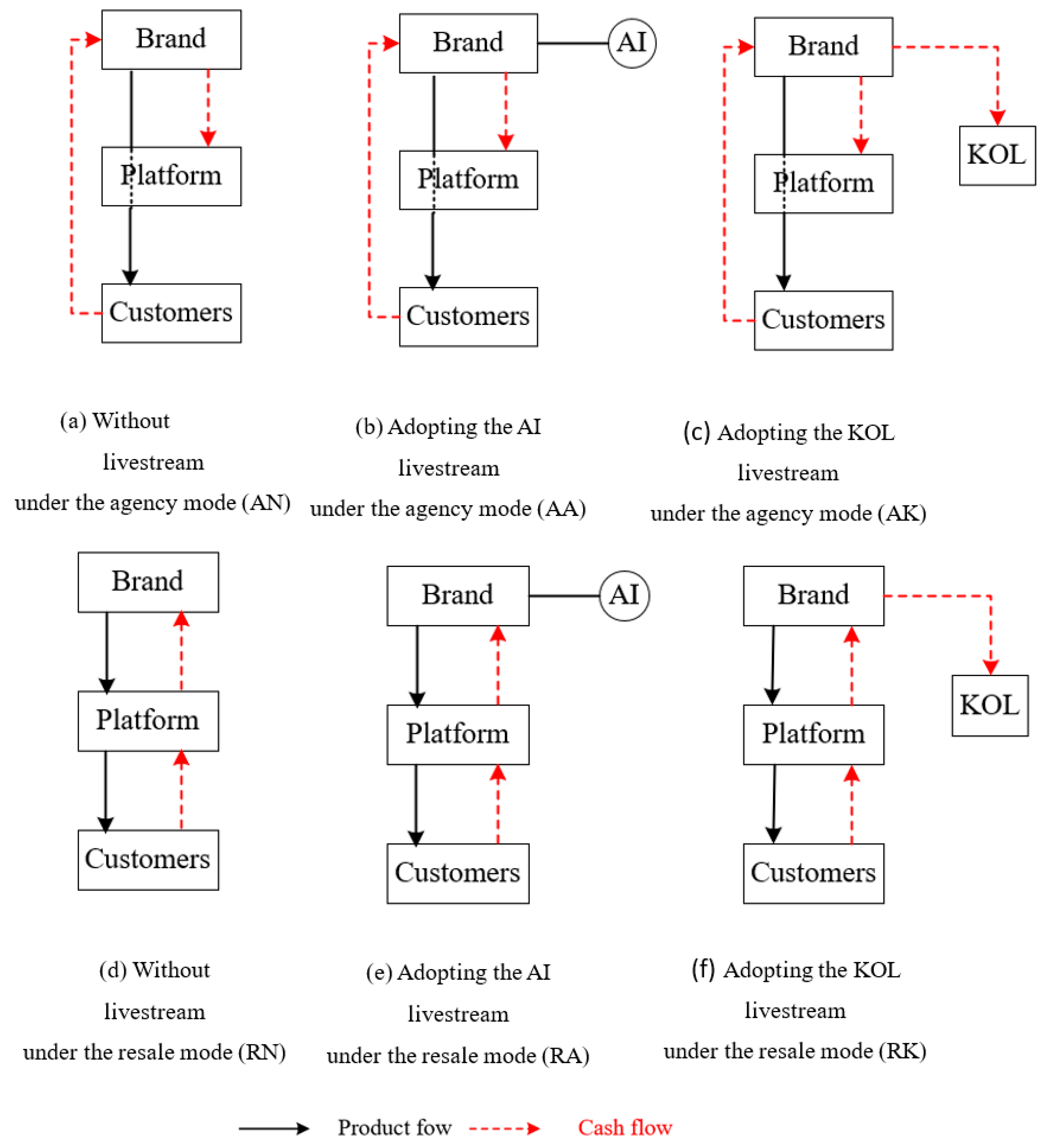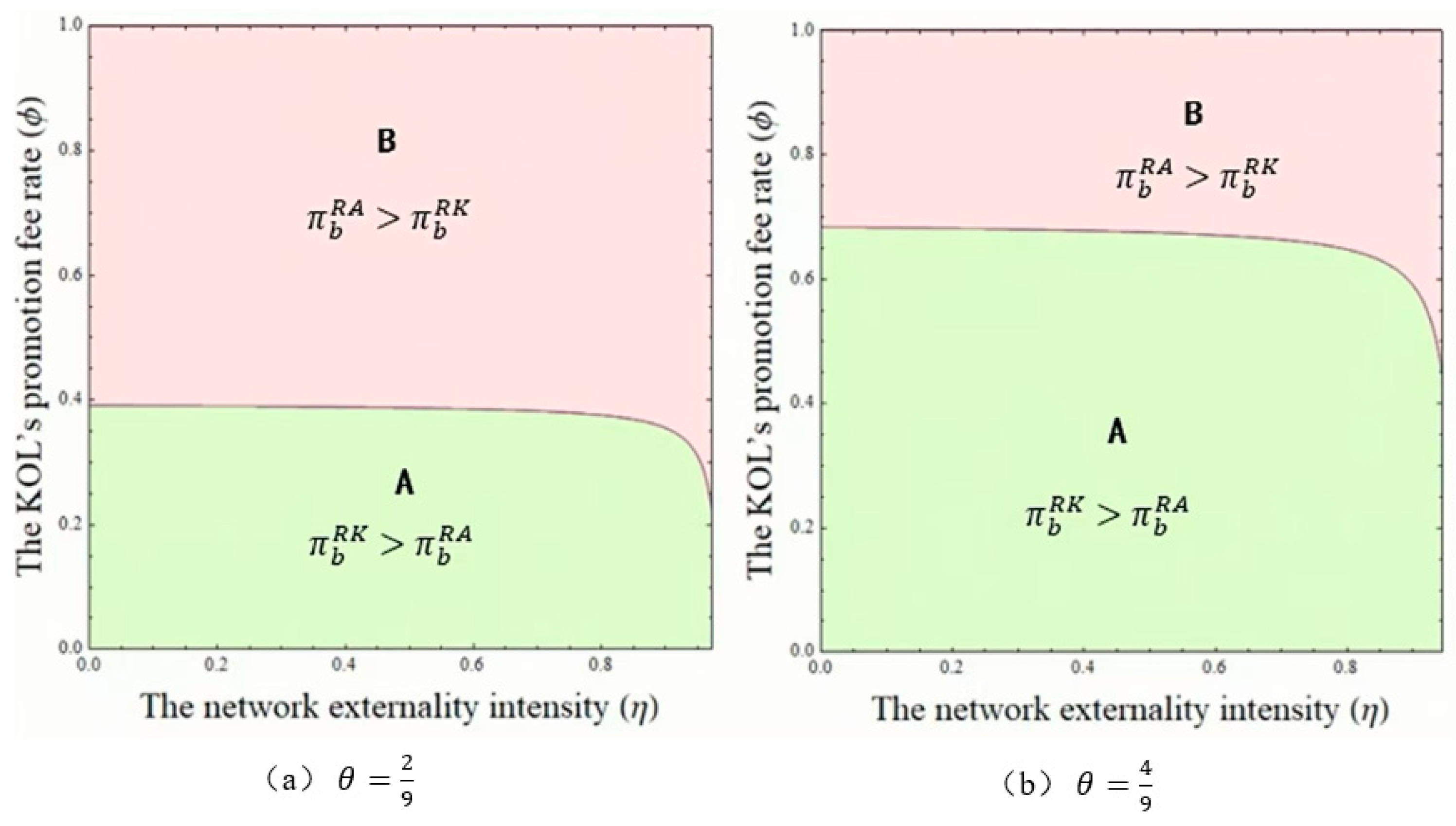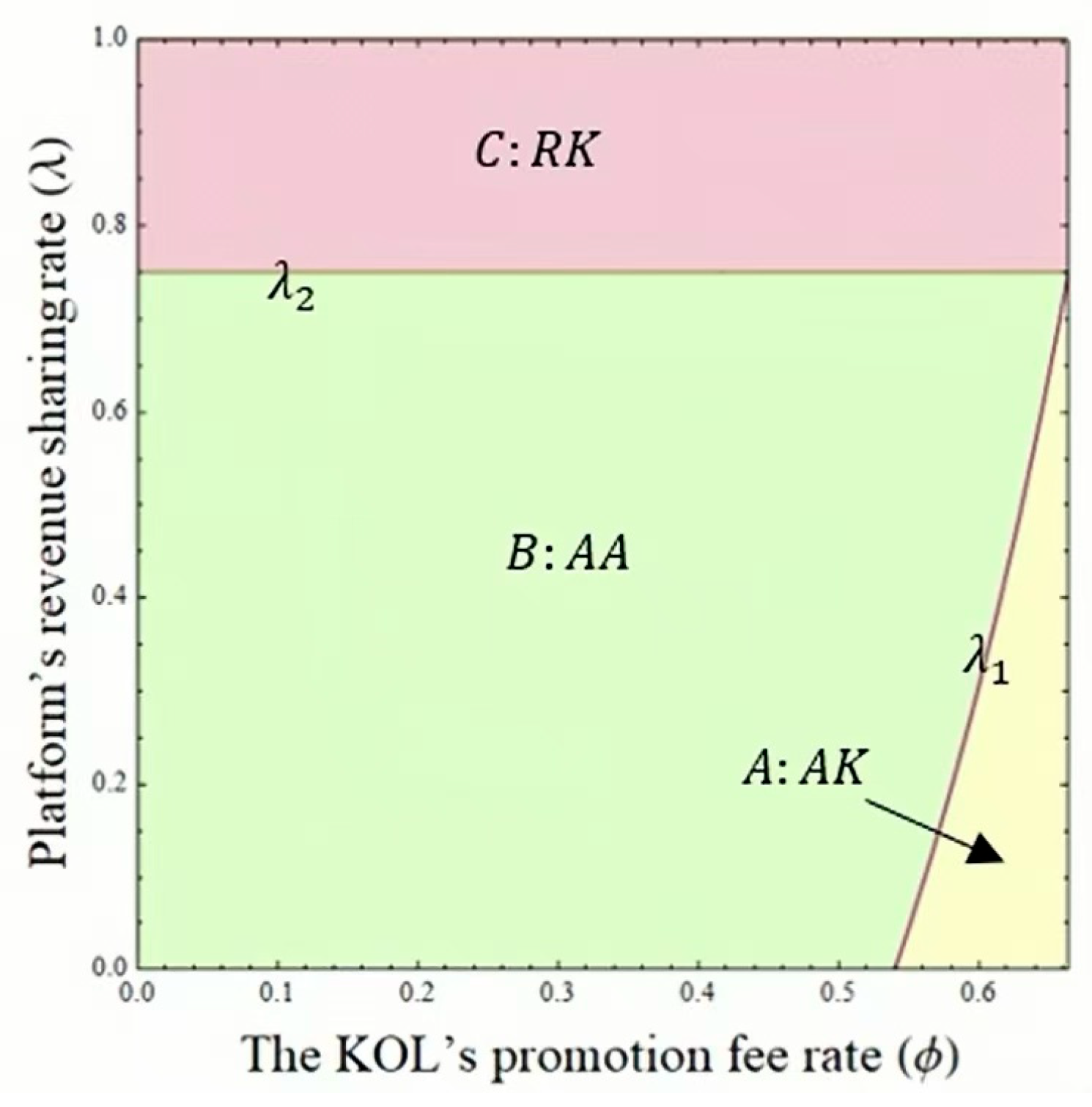Livestream Scheme Selection in the E-Commerce Supply Chain: Under Agency and Resale Sales Modes
Abstract
1. Introduction
- (a)
- How do different sales modes impact pricing decisions and performance under various livestream schemes, and which sales mode should the brand select?
- (b)
- How do different livestream schemes influence pricing decisions and performance under various sales modes, and which livestream scheme should the brand select?
- (c)
- How should a brand or platform choose the optimal strategy for selecting livestream schemes and sales modes?
2. Literature Review
3. Model Formulation and Notations
3.1. Scenario 1: Different Livestream Schemes Under the Agency Mode (Aj)
3.2. Scenario 2: Different Livestream Schemes Under the Resale Mode (Rj)
4. Equilibrium Analysis
4.1. The Impact of Sales Modes on Pricing Decisions and Performance
4.2. The Impact of Livestream Schemes on Pricing Decisions and Performance
4.3. Optimal Strategy for Brand
4.4. Optimal Strategy for Platform
5. Model Extension
5.1. Extension 1: Platform Decision on Livestream Scheme
5.2. Extension 2: Different Intensities of Network Externalities
6. Conclusions and Managerial Implications
6.1. Conclusions
6.2. Managerial Implications
6.3. Limitations and Future Research
Author Contributions
Funding
Data Availability Statement
Acknowledgments
Conflicts of Interest
Appendix A
References
- Zeng, S.; Yang, C. Risk evaluation of livestream e-commerce platforms based on expert trust networks and CODAS. Expert Syst. Appl. 2025, 260, 125408. [Google Scholar] [CrossRef]
- Wang, J.; Zhang, X. The value of influencer channel in an emerging livestreaming e-commerce model. J. Oper. Res. Soc. 2023, 74, 112–124. [Google Scholar] [CrossRef]
- Alixpartners. Available online: https://www.alixpartners.com/newsroom/chinese-consumers-rally-for-singles-day-2020/ (accessed on 8 October 2024).
- Chen, Y.; Wang, Y.; Zheng, J.; Song, Y.; Wen, Y. Self-reliance vs. Dependence: Optimal live streaming strategies selection for E-retailers at different developmental stages. J. Retail. Consum. Serv. 2025, 84, 104225. [Google Scholar] [CrossRef]
- CEIBS. Available online: https://www.ceibs.edu/new-papers-columns/ready-join-livestreaming-commerce-think-you-leap (accessed on 20 October 2024).
- CHOZAN. Available online: https://chozan.co/blog/is-kuaishou-the-future-of-live-streaming-in-china-2/ (accessed on 20 October 2024).
- Influencer Marketing Hub. Available online: https://influencermarketinghub.com/kol-marketing/ (accessed on 20 October 2024).
- 36Kr. Available online: https://www.36kr.com/p/1263588113602436 (accessed on 20 October 2024).
- Marketing to China. Available online: https://marketingtochina.com/ai-powered-virtual-hosts-are-taking-over-e-commerce-live-streaming/ (accessed on 23 October 2024).
- SCMP. Available online: https://www.scmp.com/tech/apps-social/article/3093440/steep-discounts-and-kol-endorsements-have-supercharged-live (accessed on 23 October 2024).
- Lin, Z.; Heng, C.S. The paradoxes of word of mouth in electronic commerce. J. Manag. Inf. Syst. 2015, 32, 246–284. [Google Scholar] [CrossRef]
- Xu, M.; Tang, W.; Zhou, C. Procurement strategies of E-retailers under different logistics distributions with quality-and service-dependent demand. Electron. Commer. Res. Appl. 2019, 35, 100853. [Google Scholar] [CrossRef]
- Sohu. Available online: https://www.sohu.com/a/523096976_121057985 (accessed on 24 October 2024).
- Hao, C.; Yang, L. Resale or agency sale? Equilibrium analysis on the role of live streaming selling. Eur. J. Oper. Res. 2023, 307, 1117–1134. [Google Scholar] [CrossRef]
- Ji, G.; Fu, T.; Li, S. Optimal selling format considering price discount strategy in live-streaming commerce. Eur. J. Oper. Res. 2023, 309, 529–544. [Google Scholar] [CrossRef]
- Liu, J.; Ke, H. Firms’ preferences for retailing formats considering one manufacturer’s emission reduction investment. Int. J. Prod. Res. 2021, 59, 3062–3083. [Google Scholar] [CrossRef]
- Zhang, S.; Zhang, J. Agency selling or reselling: E-tailer information sharing with supplier offline entry. Eur. J. Oper. Res. 2020, 280, 134–151. [Google Scholar] [CrossRef]
- Cai, S.; Li, S.; Liu, Y.; Han, X. Who should livestream first? Sequence of dual self-livestreaming rooms for manufacturers. Electron. Commer. Res. Appl. 2025, 71, 101498. [Google Scholar] [CrossRef]
- Fletcher, K.A.; Gbadamosi, A. Examining social media live stream’s influence on the consumer decision-making: A thematic analysis. Electron. Commer. Res. 2024, 24, 2175–2205. [Google Scholar] [CrossRef]
- Pun, B.L.; Fung, A.Y. Live streaming as an interactive marketing media: Examining Douyin and its constructed value and cultural preference of consumption in e-commerce. In The Palgrave Handbook of Interactive Marketing; Springer International Publishing: Cham, Switzerland, 2023; pp. 499–517. [Google Scholar]
- Sun, Y.; Shao, X.; Li, X.; Guo, Y.; Nie, K. How live streaming influences purchase intentions in social commerce: An IT affordance perspective. Electron. Commer. Res. Appl. 2019, 37, 100886. [Google Scholar] [CrossRef]
- Shen, B.; Cheng, M.; He, R.; Yang, M. Selling through social media influencers in influencer marketing: Participation-based contract versus sales-based contract. Electron. Commer. Res. 2024, 24, 1095–1118. [Google Scholar] [CrossRef]
- Zhang, X.; Shi, Y.; Li, T.; Guan, Y.; Cui, X. How do virtual AI streamers influence viewers’ livestream shopping behavior? The effects of persuasive factors and the mediating role of arousal. Inf. Syst. Front. 2024, 26, 1803–1834. [Google Scholar] [CrossRef]
- Lyu, W.; Qi, Y.; Liu, J. Proliferation in live streaming commerce, and key opinion leader selection. Electron. Commer. Res. 2024, 24, 1153–1186. [Google Scholar] [CrossRef]
- He, W.; Jin, C. A study on the influence of the characteristics of key opinion leaders on consumers’ purchase intention in live streaming commerce: Based on dual-systems theory. Electron. Commer. Res. 2024, 24, 1235–1265. [Google Scholar] [CrossRef]
- Hu, J. What Matters Customer Engagement in Live Streaming E-Commerce Platform? (The Impact of Celebrity Live Streamer Endorser Effectiveness and Social Support). Master’s Thesis, Università Ca’ Foscari, Venezia, Italy, 2021. [Google Scholar]
- Hou, F.; Guan, Z.; Li, B.; Chong, A.Y.L. Factors influencing people’s continuous watching intention and consumption intention in live streaming: Evidence from China. Internet Res. 2020, 30, 141–163. [Google Scholar] [CrossRef]
- Yu, X.; Li, T.; Tan, Q.; Liu, B.; Li, H. Brand livestream mode options: AI vs KOL livestream in the platform supply chain. Kybernetes. 2024. [Google Scholar] [CrossRef]
- Niu, B.; Yu, X.; Dong, J. Could AI livestream perform better than KOL in cross-border operations? Transp. Res. Part E Logist. Transp. Rev. 2023, 174, 103130. [Google Scholar] [CrossRef]
- Liu, W.; Yan, X.; Li, X.; Wei, W. The impacts of market size and data-driven marketing on the sales mode selection in an Internet platform based supply chain. Transp. Res. Part E Logist. Transp. Rev. 2020, 136, 101914. [Google Scholar] [CrossRef]
- Chen, Z.; Fan, Z.P.; Zhao, X. Offering return-freight insurance or not: Strategic analysis of an e-seller’s decisions. Omega 2021, 103, 102447. [Google Scholar] [CrossRef]
- Ji, X.; Li, G.; Sethi, S.P. How social communications affect product line design in the platform economy. Int. J. Prod. Res. 2022, 60, 686–703. [Google Scholar] [CrossRef]
- Yu, Z.; Wang, Y.; Ji, X. The operation decisions of trade-in program in platform-based closed-loop supply chain under different sales modes. Oper. Res. 2025, 25, 37. [Google Scholar] [CrossRef]
- Wang, T.Y.; Chen, Y.; Chen, Z.S.; Deveci, M.; Delen, D. Maximizing sales: The art of short video creation in livestream e-commerce. Comput. Ind. Eng. 2025, 200, 110824. [Google Scholar] [CrossRef]
- Wang, Q.; Zhao, N.; Ji, X. Reselling or agency selling? The strategic role of live streaming commerce in distribution contract selection. Electron. Commer. Res. 2024, 24, 983–1016. [Google Scholar] [CrossRef]
- Yang, L.; Zheng, C.; Hao, C. Optimal platform sales mode in live streaming commerce supply chains. Electron. Commer. Res. 2024, 24, 1017–1070. [Google Scholar] [CrossRef]
- Bicheng, Y.; Liu, N.; Liu, B. Reselling or agency selling? The impact of live-streaming on selling formats. Asia Pac. J. Mark. Logist. 2024, 37, 666–687. [Google Scholar] [CrossRef]
- Long, F.; Jerath, K.; Sarvary, M. Designing an online retail marketplace: Leveraging information from sponsored advertising. Mark. Sci. 2022, 41, 115–138. [Google Scholar] [CrossRef]
- Zhang, T.; Guo, X.; Wu, T. An analysis of cross-channel return processing with return-freight insurance for live streaming platforms. Comput. Ind. Eng. 2022, 174, 108805. [Google Scholar] [CrossRef]
- Pan, R.; Feng, J.; Zhao, Z. Fly with the wings of live-stream selling—Channel strategies with/without switching demand. Prod. Oper. Manag. 2022, 31, 3387–3399. [Google Scholar] [CrossRef]
- Zhang, X.; Chen, H.; Liu, Z. Operation strategy in an E-commerce platform supply chain: Whether and how to introduce live streaming services? Int. Trans. Oper. Res. 2024, 31, 1093–1121. [Google Scholar] [CrossRef]
- Cui, X.; Li, Y.; Li, X.; Fang, S. Livestream e-commerce in a platform supply chain: A product-fit uncertainty reduction perspective. Int. J. Prod. Econ. 2023, 258, 108796. [Google Scholar] [CrossRef]
- Xu, X.; Wang, Y.; Cheng, T.C.E.; Choi, T.M. Should live broadcasting platforms adopt artificial intelligence? A sales effort perspective. Eur. J. Oper. Res. 2024, 318, 979–999. [Google Scholar] [CrossRef]
- Niu, B.; Yu, X.; Li, Q.; Wang, Y. Gains and losses of key opinion leaders’ product promotion in livestream e-commerce. Omega 2023, 117, 102846. [Google Scholar] [CrossRef]
- Chen, F. Salesforce incentives, market information, and production/inventory planning. Manag. Sci. 2005, 51, 60–75. [Google Scholar] [CrossRef]
- Lin, X.; Gui, L.; Lu, Y. Managing sales via livestream commerce: Implications of price negotiation and consumer price search. Prod. Oper. Manag. 2024. [Google Scholar] [CrossRef]
- Du, Z.; Fan, Z.P.; Sun, F.; Liu, Y. Open the live streaming sales channel or not? Analysis of strategic decision for a manufacturer. Ann. Oper. Res. 2023. [Google Scholar] [CrossRef]
- Liu, Z.; Cui, X.; Ji, Y. Balancing E-Commerce Platform and Manufacturer Goals in Sustainable Supply Chains: The Impact of Eco-Friendly Private Labels. Systems 2025, 13, 36. [Google Scholar] [CrossRef]





| Reference | Livestream | Livestream Traffic Generation | AI vs. KOL | Selection of Sales Mode | Selection of Sales Models in Livestream E-Commerce | Horizontal Interaction |
|---|---|---|---|---|---|---|
| Cai et al. [18] | √ | |||||
| Pun and Fung [20] | √ | √ | ||||
| Yu et al. [28] | √ | √ | ||||
| Niu et al. [29] | √ | √ | ||||
| Shen et al. [22] | √ | √ | ||||
| Hou et al. [27] | √ | √ | ||||
| Hao and Yang [14] | √ | |||||
| Yu et al. [33] | √ | |||||
| Wang et al. [34] | √ | √ | √ | |||
| Yang et al. [36] | √ | √ | √ | |||
| Bicheng et al. [37] | √ | √ | √ | √ | ||
| This paper | √ | √ | √ | √ | √ | √ |
| Notation | Explanation |
|---|---|
| The consumer demand, , | |
| The market disadvantage because of consumers’ distrust | |
| The demand potential, | |
| Platform’s revenue sharing rate | |
| The KOL’s promotion fee rate | |
| The network externality intensity | |
| The brand’s profit, , | |
| The platform’s profit, , | |
| The KOL’s profit, , | |
| Indices | |
| Agency mode, resale mode | |
| without livestream, adopting AI livestream, adopting KOL livestream | |
| brand | |
| platform | |
| Decision variables | |
| The effort of the brand to enhance consumers’ trust in the online channel in AI livestream | |
| Retail price, , | |
| Wholesale price, , |
| Not Adopting Livestream | Adopting AI Livestream | Adopting KOL Livestream | |
|---|---|---|---|
| Agency mode | , | , | , |
| Resale mode | , | , | , |
Disclaimer/Publisher’s Note: The statements, opinions and data contained in all publications are solely those of the individual author(s) and contributor(s) and not of MDPI and/or the editor(s). MDPI and/or the editor(s) disclaim responsibility for any injury to people or property resulting from any ideas, methods, instructions or products referred to in the content. |
© 2025 by the authors. Licensee MDPI, Basel, Switzerland. This article is an open access article distributed under the terms and conditions of the Creative Commons Attribution (CC BY) license (https://creativecommons.org/licenses/by/4.0/).
Share and Cite
Li, T.; Xu, S.; Tan, Q.; Teng, W. Livestream Scheme Selection in the E-Commerce Supply Chain: Under Agency and Resale Sales Modes. Systems 2025, 13, 397. https://doi.org/10.3390/systems13050397
Li T, Xu S, Tan Q, Teng W. Livestream Scheme Selection in the E-Commerce Supply Chain: Under Agency and Resale Sales Modes. Systems. 2025; 13(5):397. https://doi.org/10.3390/systems13050397
Chicago/Turabian StyleLi, Tao, Shanping Xu, Qi Tan, and Wenbo Teng. 2025. "Livestream Scheme Selection in the E-Commerce Supply Chain: Under Agency and Resale Sales Modes" Systems 13, no. 5: 397. https://doi.org/10.3390/systems13050397
APA StyleLi, T., Xu, S., Tan, Q., & Teng, W. (2025). Livestream Scheme Selection in the E-Commerce Supply Chain: Under Agency and Resale Sales Modes. Systems, 13(5), 397. https://doi.org/10.3390/systems13050397







